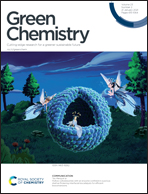Solvent-driven C(sp3)–H thiocarbonylation of benzylamine derivatives under catalyst-free conditions†
Abstract
Due to the particularity of the thiocarbonyl group (C![[double bond, length as m-dash]](https://www.rsc.org/images/entities/char_e001.gif) S bond), only limited C(sp3)–H thiocarbonylation methods, especially efficient and convenient methods, have been developed for the synthesis of thioamides. Inspired by the “solvent-specificity-based” design strategy, we discovered a simple, practical and environmentally friendly C(sp3)–H thiocarbonylation of benzylamine substrates for facile thioamide synthesis under catalyst-free conditions. A diverse array of benzylamine derivatives were tolerated by this catalyst-free thiocarbonylation. Furthermore, the (QM) computations and well-designed experiments on the reaction mechanism revealed that this thiocarbonylation depends on the specific solvent that initially drives this reaction through the intermolecular hydrogen atom transfer (HAT). And the following single electron transfer (SET) induces the electron-catalyzed C–S bond formation and intramolecular HAT realizing the final establishment of the C
S bond), only limited C(sp3)–H thiocarbonylation methods, especially efficient and convenient methods, have been developed for the synthesis of thioamides. Inspired by the “solvent-specificity-based” design strategy, we discovered a simple, practical and environmentally friendly C(sp3)–H thiocarbonylation of benzylamine substrates for facile thioamide synthesis under catalyst-free conditions. A diverse array of benzylamine derivatives were tolerated by this catalyst-free thiocarbonylation. Furthermore, the (QM) computations and well-designed experiments on the reaction mechanism revealed that this thiocarbonylation depends on the specific solvent that initially drives this reaction through the intermolecular hydrogen atom transfer (HAT). And the following single electron transfer (SET) induces the electron-catalyzed C–S bond formation and intramolecular HAT realizing the final establishment of the C![[double bond, length as m-dash]](https://www.rsc.org/images/entities/char_e001.gif) S bond.
S bond.



 Please wait while we load your content...
Please wait while we load your content...